When a human resource is unable to handle the continuous demand for customer service well, organisations switch to AI-powered chatbots. AI chatbots are now being used in various fields to improve customer service and thus the revenue.
“We are now witnessing a new shift in computing: the move from a mobile-first to an AI-first world.” —Sundar Pichai, CEO of Google
The advances in technology have increased exponentially, which has brought a revolution in the user interface by extracting maximum value from artificial intelligence (AI) to enhance the productivity of businesses and boost their revenue. In recent years, the intense innovations in machine learning and other fundamental technologies like natural language processing have led to an astonishingly widespread use of chatbots or conversational agents that facilitate the human-to-bot interaction, which is the biggest dominating mobile trend of this time.
Chatbots, derived from ‘chat robots,’ are text- or voice-based algorithms powered by AI that are capable of checking the customers’ needs and providing possible suggestions. These are now gaining more popularity on Facebook Messenger, Twitter, LinkedIn, Skype, Slack, Kik, and other messaging platforms.
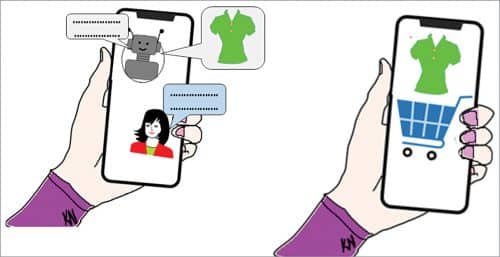
The human-to-bot interaction lets the users have normal conversation in dialogue form, entering their purposes directly into the machines to buy things, to book their place in the salon, to make hotel reservation, to get online health advise, or to even get directions. The chatbot appears as if the machine language has been humanised and is making the computers or mobile phones to adopt the human world. But, in fact, the human language is being mechanised to bring us into the machine world!
Chatbots, virtual assistants and live chat software
Chatbots and virtual assistants (VA) are both smart applications of AI and they both are conversational interfaces. Chatbots are automated software that is company-oriented, programmed with a learned set of knowledge and reacts to users’ questions by providing a pre-defined answer. Whereas VAs like Cortana or Siri are digital assistants, similar to human assistants, that deal with an individual user, like organising and reminding business appointments, handling to-do lists, setting up alarms, and assisting in other daily routines.
Chatbots, being information acquisition tools, facilitate customers’ communication with any business venture. An organisation can build its customised chatbot for virtual conversation with its customers using a technology called Natural Language Processing (NLP). The NLP algorithm is making the chatbot smarter.
VA uses high-level automation software, based on advanced NLP, which enables it to understand natural language voice commands and interact with the individual user, offering human-like assistance in a highly effective way. VA follows the dynamic conversational flow technique, which means it can interact with human beings continuously, even if the communication is not continuous, and can remember the fundamental perspective of the conversation. Instead, a chatbot fails to retain the conversation because it lacks in dialogue management, which makes the customer start all over again. However, this flaw has been overcome in Google’s Meena chatbot by using powerful encoders and decoders.
So, organisations need to focus on appropriate areas where the AI applications, VAs, and chatbots can be implemented correctly to leverage their business. This article points out some sectors where the organisations’ revenue and customer retention rates have increased due to the usage of chatbots.
Chatbots in e-commerce business
AI in online shopping has transformed the e-commerce industry by using chatbots to provide 24/7 support to their online customers; thus making the customers feel that they are in direct contact with the brand regardless of the time. As chatbots use NLP, they can construe the voice-based communications. So, the requirements of the customers are perceived profoundly, hence increasing their confidence in the company.
Chatbots can identify the thoughts and views of the customers from their searches and questions and can provide instant answers, facilitating good customer service. Also, they can remember the preferences of the customers so that any offers from the organisation get communicated personally to each customer.
Burberry chatbot (UK/US)
Burberry, one of the luxury fashion brands, uses a ‘see-now-buy-now’ chatbot that can be accessed by scanning a QR code or through the company’s Facebook Messenger page. This bot provides customer service support by answering frequently asked questions through categorised options, hence enabling a better ‘conversational commerce’ by allowing access to a large user database for better communication with their target audience.
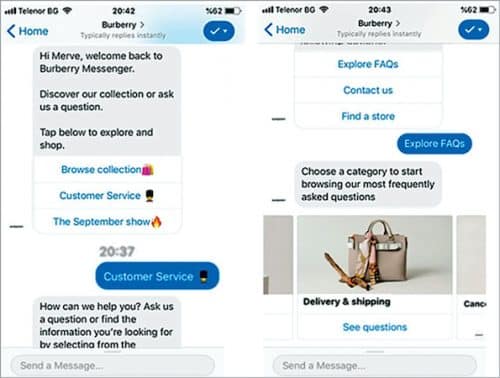
When Burberry launched its chatbot in 2016, it was only allowing its customers to have a look at their collections and shop some selected pieces. But now, the company’s chatbot can send push notifications to all the customers who communicate with it, can help the customers get in touch with the Burberry Consultant directly, can locate a particular store, or book a Uber ride to their Makers’ House.
Also, the see-now-buy-now bot allows Burberry customers to design their trench coats—the brand’s classic outwear—thus giving a personalised shopping experience to them. Shopping percentage rises when brands offer such personalised experiences, which takes marketing to a new level and targets more customers.
Nike chatbot
Nike’s chatbot, developed by Snaps.io, allows users to browse Nike footwear and clothing selections. Nike By You (previously NikeID) service encourages individuals to design their shoes either by uploading their design pictures, or by blending options, or using ‘magic match.’ As the chatbot is language agnostic, it is capable of catering to international audience.
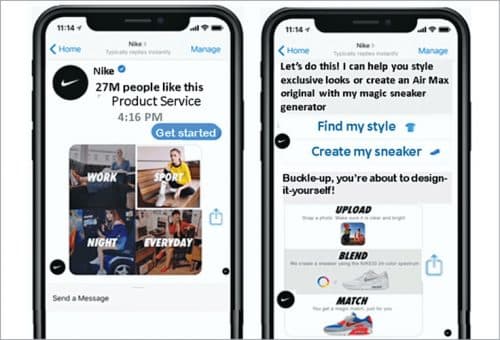
The bot interacts with the users through a multiple-choice format on topics extending from products, users’ preferences, style or size, shipping, etc. The collected information is used as input and the bot begins its search based on the users’ requirements and redirects the users to Nike’s site for purchasing the products, thus saving the customers’ effort and time.
Chatbots in the medical industry
The whole world has seen a sharp and tenacious decline in the economy due to the Covid-19 pandemic. The virus has also impacted most of our daily routine and has turned events to virtual versions. The novel pandemic has made the medical industry also go through ups and downs throughout the catastrophe. So, this industry has now taken the centre-stage position among all the sectors. Establishments like the Centers for Disease Control & Prevention (CDC) and World Health Organization (WHO) have shown the potential of chatbots in saving lives. These organisations are using chatbots to share information, to recommend actions and procedures that support our health, and to offer emotional support.
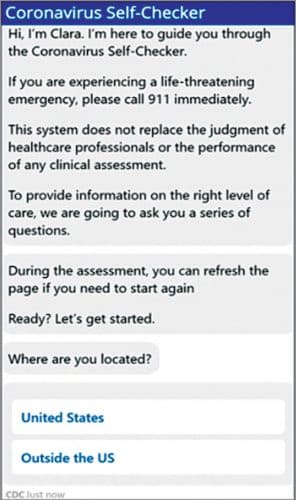
CDC’s Clara chatbot. CDC was using a chatbot named ‘Clara’ that was built on Microsoft’s Healthcare Bot powered by tech giant Azure’s cloud architecture. This chatbot is available any time of the day to give up-to-date information. It can hear and respond in natural language and it can simultaneously speak to millions of people in their local languages and dialects.
During the peak of Covid-19 outbreak, doctors, nurses, and administrators were overwhelmed with the number of cases they had to attend. Clara could differentiate individuals with high-risk and low-risk factors and thus helped healthcare professionals to focus first on patients who needed critical care.
WHO’s Health Alert chatbot
WHO has launched a chatbot on Facebook Messenger and WhatsApp, called WHO Health Alert, which provides instant and accurate information about Covid-19. The chatbot was developed in collaboration with Sprinklr and in partnership with Praekelt.Org using Turn machine learning technology.
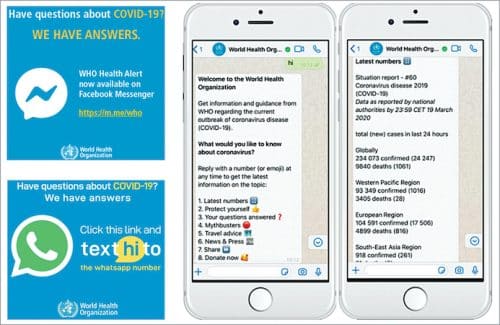
This chatbot can be accessed in Arabic, English, French, Hindi, Italian, Spanish, and Portuguese languages for correct information about coronavirus and what people can do to protect themselves and others.
Chatbots for human resource
AI has transformed the landscape of human resource management. Chatbots have set foot in the workplace in the form of HR chatbots that automate most of the tasks in the HR departments like recruiting, managing payroll, managing training skills or professional development, and furnishing any other new prospects to boost employee experience. This advanced automation reduces human participation and expenses.
Each workplace is now adopting new conversational interfaces to interact with employees to have personalised but frictionless interactions. Organisations prefer chatbots because these are capable of engaging across multiple channels like a website, a mobile app, Microsoft Teams, Slack, or any other messaging app.
XOR chatbot for recruiting
XOR AI can speak 103 languages to attract applicants from all around the world! It is an easy-to-use chatbot that requires no coding skills and can be integrated with most of the applicant tracking systems and HR technology platforms within a day and maximum up to two weeks.
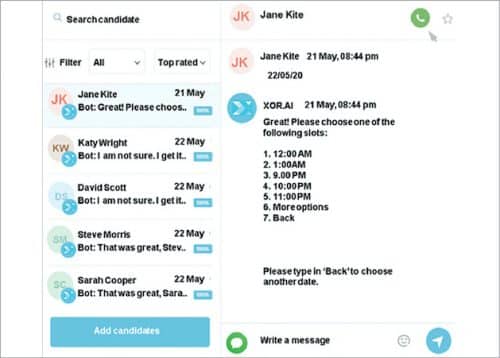
XOR chatbots select resumes that match the job requirements, call the selected candidates, and arrange for interviews. This process is completed within minutes whereas the same procedure requires three to four weeks for the HR department. XOR is finding application in companies like ALDI, CISCO, Heineken, and IKEA.
Wade and Wendy chatbots. Wade and Wendy are two different chatbots for recruitment that use advanced AI technology for conversational intelligence. Chatbot Wade guides the job seekers by helping them find a job they aspire for and describing them the job criteria; Wendy ensures that it screens the applicants based on the given job criteria.
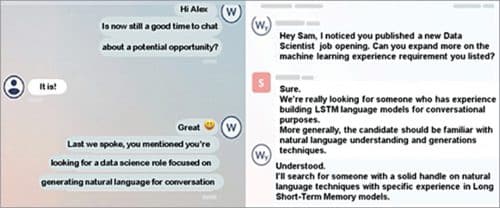
Wendy makes the hiring process more humane by keeping each applicant engaged as the recruitment is chat-driven with role-specific conversations. It helps the HR throughout the hiring process by acquiring and synthesizing the information and finally making its recommendation about the best fit for the specified job role.
Wendy’s conversation with the applicants is not identical because its response is based on what the applicants say. Wendy is capable of diving deeper into the applicants’ responses and can ask follow-up questions to get a better understanding of the candidate’s skills, depth of experience, and familiarity with certain processes or tools.
Chatbots in tourism and hospitality
The atavistic wish to voyage all around the world is inherent in every individual. According to Google, 82 per cent of travellers use the Internet for planning their travel and making online bookings. The rise and shine of chatbots has made a positive impact in customer interactions in the tourism sector, hotels, and other hospitality-related businesses. Leading companies like Skyscanner, Expedia, and Booking.com have already transformed digitally by using chatbots to retain their sales momentum.
Mezi for travel agencies. AI-powered Mezi is a free chatbot that assists travellers in making their travel plans simple, fast, and easy. It is integrated into Facebook Messenger, Slack, and Skype and can answer more complex questions than any other travel AI as it is equipped with a large dataset of itineraries, room inventory, and pricing details.
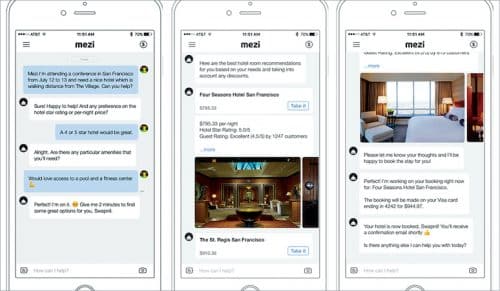
For the given dates and destinations, Mezi can provide the best flight and accommodation options and can also make recommendations like the best time to visit a particular place. Mezi is powerful in picking up the hints of the traveller’s needs from their own words and can reply to them instantly with all possible suggestions and recommendations. Besides working for travellers, Mezi offers business subscriptions for travel agencies and travel management companies.
HiJiffy for hotels
Chatbots are also being used by hotels to handle customer lexicon by centralising, automating, and measuring all customer care activities. Customers can contact chatbot HiJiffy through any messaging channel; it can recognize and respond to the customers instantly, creating a fast-track revenue stream for the hotels. More than 500 hoteliers and property owners running their businesses in 30 countries use HiJiffy.
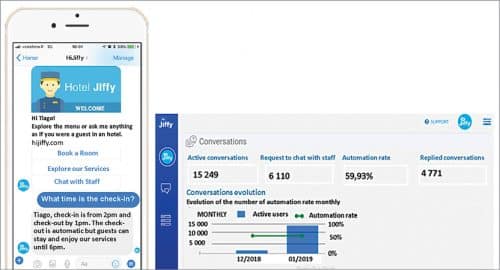
Conclusion
When a human resource is unable to handle the continuous demand for customer service well, organisations switch to AI-powered chatbots. AI chatbots are now being used in various fields to improve customer service and thus the revenue. Chatbots are useful not only for the cutting-edge tech companies but also for any start-up companies striving to scale up fast. You can also consider them to increase your sales by using this innovative way to engage your customers, enhance your company’s vision, and look up to a better future!
Dr Krishna Naga works as a Physics teacher. She has over twenty years of experience in this field. Her hobbies include reading and writing






